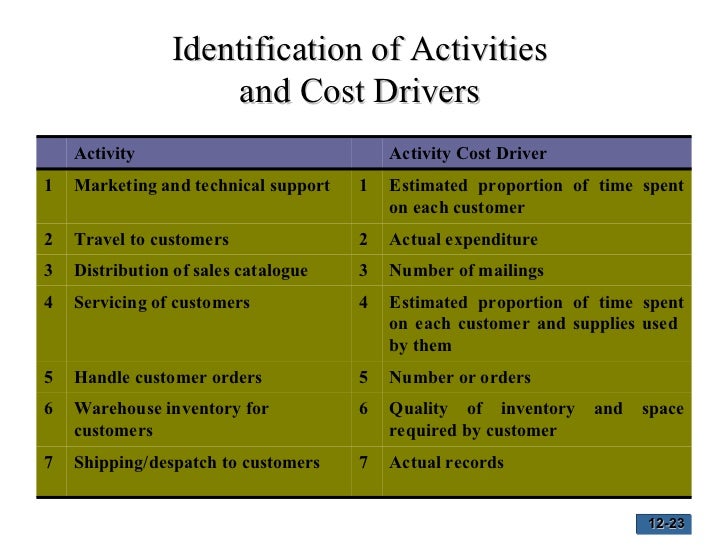Cost Drivers Examples In Service Industry

It is illegal for you to distribute copyrighted files without permission. Aio.how is not responsible for third party website content. Aio.how is Media search engine and does not host any files, No media files are indexed hosted cached or stored on our server, They are located on soundcloud and Youtube, We only help you to search the link source to the other server. Ravanaprabhu ariyathe song download.
Particularly in the health care industry, identification of cost drivers can be of benefit to all involved. Identification of overhead or indirect cost drivers can be the impetus for more efficient management of the national resources devoted to health care. As stated by the authors, this article focuses on the identification of cost drivers of the general service (nonrevenue earning) departments costs. These overhead costs are significant and can exceed 35% of total hospital costs. Nonrevenue earning departments provide general services such as cafeteria and housekeeping, the costs of which are allocated to the revenue earning departments. Complex organizations like hospitals are expected to benefit most from systems that utilized both volume and nonvolume-based cost driver information. However, on average hospitals do not have good quality information nor identified cost drivers.
For purposes of this paper complexity is defined by the authors as the number of services (breadth of complexity) and the intensity of individual services (depth of complexity). Motivation More accurate assignment of hospital overhead costs using appropriate cost drivers should make cost data more reliable for pricing land other purposes where each hospital is most concerned with its own cost parameters.
In addition, the provision of cost driver information helps hospital managers determine the profitability of insourcing vs. Outsourcing certain activities and monitor cost of nonvalue-added activities. However, due to the limitations of data availability, this study does not address these particular issues. Contribution Further step toward the identification of variables that drive the costs of U.S. Skin winamp keren 3d pictures. Hospital overhead activities.
The current accounting literature is filled with activity based costing ABC~ articles about cost drivers in manufacturing settings but very few examples of cost. For service organizations, accurate information from the company's accounting. In our cleaning company example, the driver of overhead costs in the customer.
Management accounting literature is replete with assertions and assumptions about cost behavior, however, little evidence exists, and thus this paper will add insight into how costs behave in hospitals. Extension of earlier research in health care economics conducted prior to the emergence of the cost driver paradigm. Complements prior cost driver research by the use of U.S.
Wide data and the simultaneous determination of hospital overhead costs, the number of services provided (breadth complexity), the intensity of individual services (depth complexity), and the use of proxy variables for volume and complexity cost drivers in a two-stage least squares model. Develops a model in which hospitals choices of service breadth and depth are simultaneously determined with the level of overhead support costs. Methodology Numerous studies across different industries have suggested that volume and complexity are important drivers of overhead costs. Therefore, along the lines of previous studies this paper utilizes a regression model of overhead costs as estimated as a function of volume, capacity, complexity, and other variables for a sample of short-term acute care hospitals throughout the U.S. Overhead costs are hypothesized to depend upon complexity as well as other factors. Complexity is represented by number of services and specialties provided by the hospital and average direct cost per ancillary specialty (depth of services provided).
Consequently, these two variables, breadth and depth, proxy for service complexity. 2SLS models will be estimated on three separate equations: the overhead cost, the breadth of services, and the depth of services equations. Sample Broad cross-section of short-term acute care hospitals of varying sizes, service breadth and service depths.
The authors assume that the hospitals in the sample chose service breadth and depth simultaneously with the level of overhead support for hospital services, if not simultaneous equation bias (endogeneity bias) is introduced, which effects parameter estimates in the overhead cost equation. Overhead Costs and Hospital Transactions Choice of proxy variables to proxy for hospital transactions complexity is restricted by the HCFA cross-sectional data set. Cost drivers that might more precisely proxy for specific logistical transactions, balancing transactions, quality transactions, and change transactions, are not available in the data set. Logistical transactions are concerned with the reception and movement of hospitals materials.
Balancing transactions deal with the coordination of health care activities within the hospital. Quality transactions are necessary to ensure patients receive quality treatment in all aspects of their hospital experience. Change transactions serve to revise health care procedures and individual patient care. Overall, hospital overhead costs may be caused by volume (number of patient days and number of discharges), capacity (number of available hospital beds), and complexity (number of medical services and depth of ancillary services).